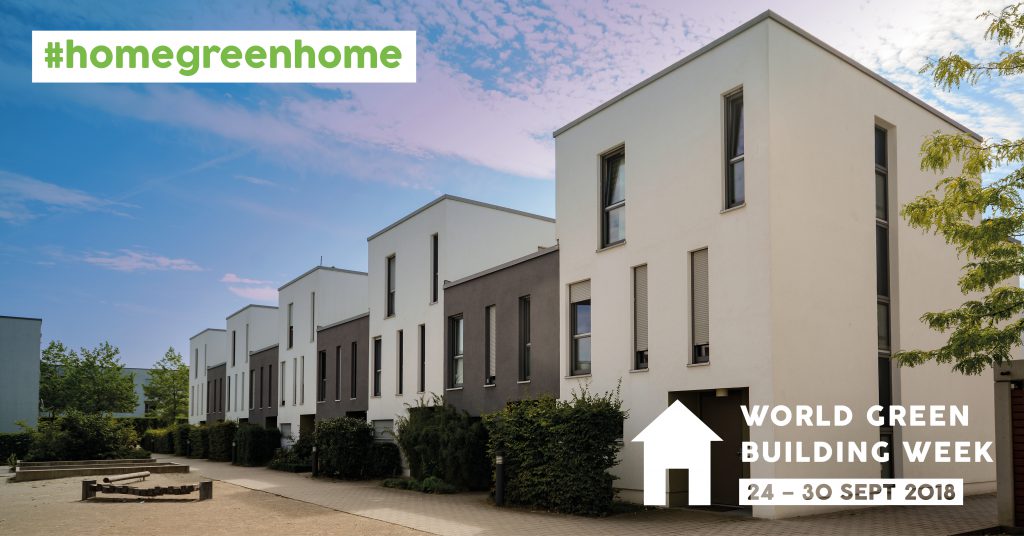Achieving a greener world starts at home
Did you know that, according to the World Green Building Council (World GBC), buildings and homes account for approximately 40% of global energy consumption? This equates to more than a third of the world’s greenhouse gas emissions. The good news is, that through actively choosing to make greener choices, we can all do our bit to transform our homes into ones that are greener and more sustainable.
That’s why 2018’s World Green Building Week theme was selected as #HomeGreenHome, with the purpose of calling everyone to action and encouraging commitment from people all around the world to making a change in the homes they either live in or build. Everyone can do something to make their home greener, however small the change. From using low or no-VOC paints to choosing to use LED lights or installing water saving devices and systems, homes around the world can start changing the landscape of the built environment and encourage a change in behavioural choices that curb unnecessary consumption and waste.
What are some the benefits of Green Homes?
A greener home leads to a myriad of benefits. These include:
- A reduced environmental footprint
- Conserving resources and reducing dependency on dirty energy
- Increased occupant wellness and happiness
- Reduced utility costs
Green homes also provide some of the building blocks towards several UN Sustainable Development Goals, from contributing to global health and well-being, creating jobs and boosting the economy, to helping solve the water crisis experienced globally by conserving water resources. Take a look below at some of the other ways green homes and buildings provide the foundation for many of the UN Sustainable Development Goals:

How can we achieve greener homes?
As mentioned before, there are a number of small-scale changes that are a great starting point in achieving a greener home. If you’d like to find out creative ways in which you can do this, have a look at our blog here for useful tips.
There are also specialised tools that can be employed to achieve a more environmentally sound home, right from the design phase. With the help of green building tools such as the EDGE green building certification and Energy Modelling, we can achieve greener homes on a small and large scale.
How can the EDGE certification lead to a greener home?
EDGE, which stands for Excellence in Design for Greater Efficiency, is a Green Building Rating tool that is focused on increasing the resource efficiency for several building types, especially in the context of homes and large-scale residential buildings in South Africa.
EDGE certified homes help people optimise the performance of their building design through achieving a minimum saving of 20% in the following 3 categories: operational energy, water usage and reduction in embodied energy of materials. With EDGE certified residential buildings, homeowners are able to reduce their carbon emissions and better the communities within which their homes are present, as well as benefit from long-term environmental and economic savings.
Some of the benefits of having an EDGE certified home:
- At least 20% more energy efficient
- Has sustainability embedded into building design
- Sells better, is more affordable and leads to long-term economic savings
- Uses at least 20% less water
- Leads to long-term environmental savings, such as reduced carbon footprint
- Has at least 20% less embodied energy of materials
We are humbled to have worked on South Africa’s first EDGE certified residential project, Four Leaf Estate in Port Elizabeth, which, through its improved efficiency, will result in an annual utility bill saving of around R1280 per unit for its residents.
How can Energy Modelling lead to a greener home?
Through the use of engineering software tools, one can design computerised models of a building’s envelope and energy systems in order to ensure that the most effective balance between heating, cooling, lighting, ventilation and thermal comfort is achieved. This can greatly assist in the design and construction phase of a building by better equipping the choice of materials to optimise its energy systems so as to reduce dependency on energy use.
Through transforming our homes into ones that prioritise resource efficiency and overall sustainability, we can slowly transform the built environment into one that protects the earth and its precious resources without compromising on occupant comfort.
Further Reading:
About the UN Sustainable Development Goals
The UN Sustainable Development Goals aim to address global challenges, such as poverty, inequality, climate, environmental degradation, prosperity, and peace and justice, and outline ways to achieve a more sustainable future for everyone.
About World Green Building Week
World Green Building Week is an annual event hosted by the World GBC which motivates and empowers people and organisations to take action and commit to delivering greener buildings for the benefit of both people and the planet alike.


